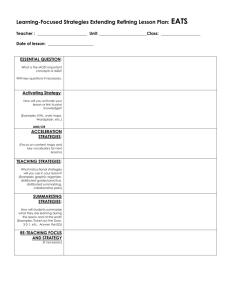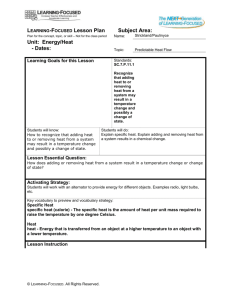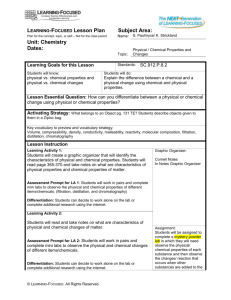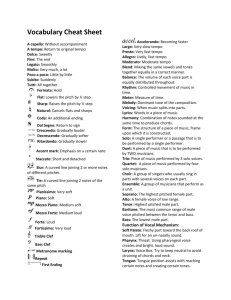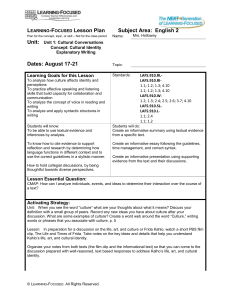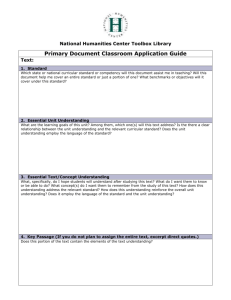Dynamics Loud Soft Piano Forte Pianissimo Mezzo
advertisement
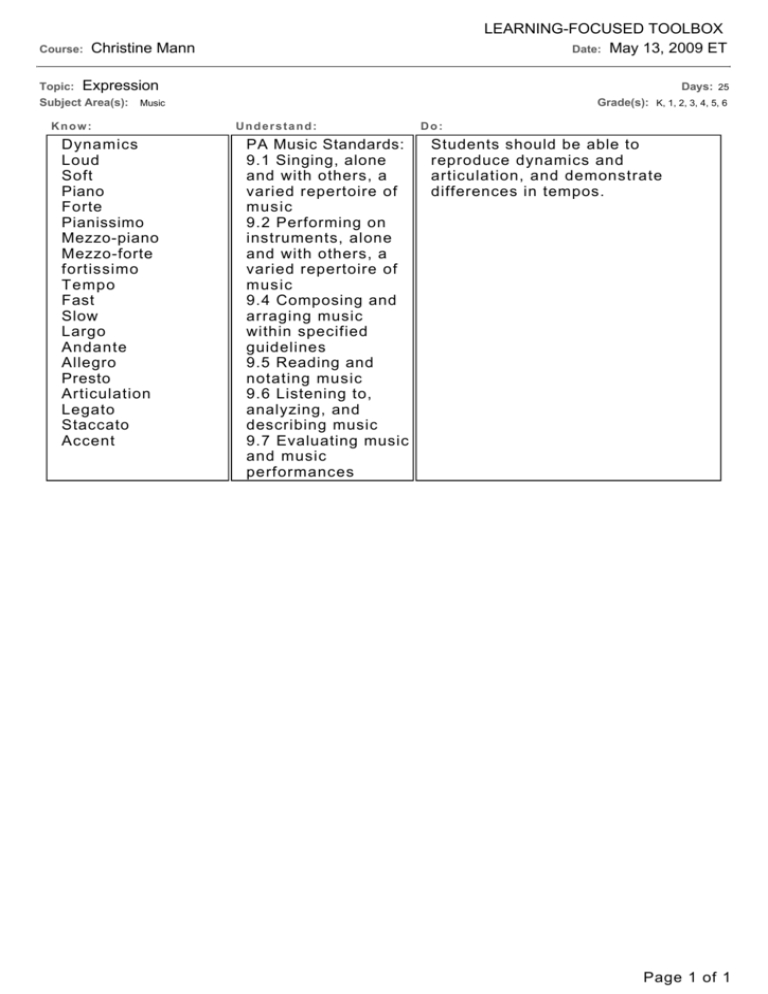
Course: LEARNING-FOCUSED TOOLBOX Date: May 13, 2009 ET Christine Mann Topic: Expression Subject Area(s): Music Know: Dynamics Loud Soft Piano Forte Pianissimo Mezzo-piano Mezzo-forte fortissimo Tempo Fast Slow Largo Andante Allegro Presto Articulation Legato Staccato Accent Days: 25 Grade(s): K, 1, 2, 3, 4, 5, 6 Understand: PA Music Standards: 9.1 Singing, alone and with others, a varied repertoire of music 9.2 Performing on instruments, alone and with others, a varied repertoire of music 9.4 Composing and arraging music within specified guidelines 9.5 Reading and notating music 9.6 Listening to, analyzing, and describing music 9.7 Evaluating music and music performances Do: Students should be able to reproduce dynamics and articulation, and demonstrate differences in tempos. Page 1 of 1 Course: Christine Mann LEARNING-FOCUSED TOOLBOX Date: May 13, 2009 ET Topic: Expression Subject Area(s): Music Days: 25 Grade(s): K, 1, 2, 3, 4, 5, 6 Common Assessments on what students should know and do in this unit: Student Assessments Culminating Activities • What changes would you add to make a piece of music more interesting? Page 1 of 1 Course: Christine Mann Topic: Expression Subject Area(s): Music LEARNING-FOCUSED TOOLBOX Date: May 13, 2009 ET Days: 25 Grade(s): K, 1, 2, 3, 4, 5, 6 2. Assessments 1 Short Description: Time (in days): 0 Page 1 of 1 Course: Christine Mann LEARNING-FOCUSED TOOLBOX Date: May 13, 2009 ET Topic: Expression Subject Area(s): Music Days: 25 Grade(s): K, 1, 2, 3, 4, 5, 6 2. Culminating Activity 1 Short Description: What changes would you add to make a piece of music more interesting? Long Description: Given a poem or song to work with, students will use musical expression to make the basic words come to life. Students will demonstrate understanding of dynamics, tempo, and articulation to produce a unique composition. Mini Lesson: Briefly review dynamics, tempo and articulation and their uses. Break students up into small groups. Each group will receive a copy of the same poem or song. Groups will apply their knowledge of musical expression to enhance the reading of the poem or song. Students may have the chioce of using instruments to aid in the process. Steps or Task Analysis: 1) Groups should read the poem or song together. 2) Groups will decide where, when and how to apply dynamics. 3) Groups will decide where, when and how to alter tempo. 4) Groups will decide where, when and how to apply articulations. 5) Groups will rehearse their poem or song so that all students in the group are on "the same page". 6) Groups will perform their interpretation for the rest of the class. Summarize/Share: Each group will perform their interpretation of the poem or song for the class. The other students will rate the interpretation using a teacher-guided rubric. Differentiation: K-2 will not be expected to use articulation. 2-6 will use a rubric for assessment. Review / Revise: Peer evaluation- groups will talk to each other and share likes and what might have been changed to make the poem or song better. Resources and Materials: A poem or song, grading rubric for 2-6, possibly instruments Time (in days): 1 Page 1 of 1 Course: LEARNING-FOCUSED TOOLBOX Date: May 13, 2009 ET Christine Mann Topic: Expression Subject Area(s): Music Days: 25 Grade(s): K, 1, 2, 3, 4, 5, 6 Key Learning: Music is more than just notes. What you do with and to these notes is what makes them turn into a truly musical expreience. Unit Essential Question(s): H ow does expression affect music? Concept: Concept: Concept: Dynamics Tempo Articulation To have students understand dynamics and their application to music. Students should understand the concept of tempo and its application to music. Students should understand the concept of articulation and its application to music. Lesson Essential Question(s): K-2 How are loud and soft sounds produced in music? (A) Lesson Essential Question(s): K-2 What are ways to show fast and slow tempo? (A) Lesson Essential Question(s): K-2 What is accent? (A) 3-4 What are the symbols used to show different levels of loud and soft sound, and how do you demonstrate them? (A) 3-4 How do we describe and show change in tempo? (A) 5-6 What is the terminology used to describe tempo? (A) 3-4 How do we use articulation in music? (A) 5-6 What terminology is used to indicate articulation in music? (A) 5-6 What are the symbols used to indicate sound levels and how would you demonstrate them? (A) Vocabulary: PP, p, mp, mf, f, ff, loud, soft Vocabulary: largo, andante, allegro, presto, fast, slow Vocabulary: articulation, legato, staccato, accent Additional Information: Attached Document(s): Page 1 of 1 Course: Christine Mann Topic: Expression Subject Area(s): Music LEARNING-FOCUSED TOOLBOX Date: May 13, 2009 ET Days: 25 Grade(s): K, 1, 2, 3, 4, 5, 6 Concept: Articulation articulation legato - smooth and connected staccato - short and detatched sound accent - emphasis on a note Concept: D y n a m i c s PP - Pianissimo- very, very soft p - Piano- soft mp - Mezzo-piano- medium soft mf - Mezzo-forte- medium loud f - Forte- loud ff - Fortissimo- very, very loud loud - high decibel level soft - low decibel level Concept: T e m p o largo - very slow andante - slow walking speed allegro - fast presto - super-fast fast - motion with speed slow - motion with no speed Page 1 of 1 Course: Christine Mann LEARNING-FOCUSED TOOLBOX Date: May 13, 2009 ET Topic: Expression Subject Area(s): Music Days: 25 Grade(s): K, 1, 2, 3, 4, 5, 6 5. Launch Activity 1 How are you going to get students engaged? Develop student interest and link their prior knowledge. Start the Student Learning Map of the unit with students. Preview key vocabulary with students.: Short Description: Recite a poem or short segment of a story with no expression. Then recite the same segment with expression. Students will compare and contrast the two examples. Using the same techniques, play a piece of music. Long Description: Recite a short text with no expression or feedback. When doing the second recitation, make it as expressive as possible- add gestures, vary the vocal inflections, act it out. Have students split into C.P.s, and do a compare and contrast G.O. Then have students listen twice to a piece of music, once with no expressive elements, and once with expressive elements. Have the students do a group share describing the difference between the two musical examples. Differentiation: Use grade level appropriate examples. Review / Revise: Use more musical examples of expression and no expression. Resources and Materials: Poems or stories, recordings, instruments, compare/contrast G.O., writing materials. Time (in days): 1 Page 1 of 1 Expression LEARNING-FOCUSED TOOLBOX Date: May 13, 2009 ET Topic: Expression Subject Area(s): Music Concept: Dynamics Days: 25 Grade(s): K, 1, 2, 3, 4, 5, 6 Course: 5. Acquisition Lessons Plan for the Concept, Topic, or Skill -- Not for the Day Lesson Essential Question: K-2 How are loud and soft sounds produced in music? What do students need to learn to be able to answer the Essential Question? Teaching Strategies: Time (in days): 1 Page 1 of 1 Expression LEARNING-FOCUSED TOOLBOX Date: May 13, 2009 ET Topic: Expression Subject Area(s): Music Concept: Dynamics Days: 25 Grade(s): K, 1, 2, 3, 4, 5, 6 Course: 5. Acquisition Lessons Plan for the Concept, Topic, or Skill -- Not for the Day Lesson Essential Question: 3-4 What are the symbols used to show different levels of loud and soft sound, and how do you demonstrate them? What do students need to learn to be able to answer the Essential Question? Teaching Strategies: Time (in days): 1 Page 1 of 1 Expression LEARNING-FOCUSED TOOLBOX Date: May 13, 2009 ET Topic: Expression Subject Area(s): Music Concept: Dynamics Days: 25 Grade(s): K, 1, 2, 3, 4, 5, 6 Course: 5. Acquisition Lessons Plan for the Concept, Topic, or Skill -- Not for the Day Lesson Essential Question: 5-6 What are the symbols used to indicate sound levels and how would you demonstrate them? What do students need to learn to be able to answer the Essential Question? Teaching Strategies: Time (in days): 1 Page 1 of 1 Expression LEARNING-FOCUSED TOOLBOX Date: May 13, 2009 ET Topic: Expression Subject Area(s): Music Concept: Tempo Days: 25 Grade(s): K, 1, 2, 3, 4, 5, 6 Course: 5. Acquisition Lessons Plan for the Concept, Topic, or Skill -- Not for the Day Lesson Essential Question: K-2 What are ways to show fast and slow tempo? What do students need to learn to be able to answer the Essential Question? Teaching Strategies: Time (in days): 0 Page 1 of 1 Expression LEARNING-FOCUSED TOOLBOX Date: May 13, 2009 ET Topic: Expression Subject Area(s): Music Concept: Tempo Days: 25 Grade(s): K, 1, 2, 3, 4, 5, 6 Course: 5. Acquisition Lessons Plan for the Concept, Topic, or Skill -- Not for the Day Lesson Essential Question: 3-4 How do we describe and show change in tempo? What do students need to learn to be able to answer the Essential Question? Teaching Strategies: Time (in days): 1 Page 1 of 1 Expression LEARNING-FOCUSED TOOLBOX Date: May 13, 2009 ET Topic: Expression Subject Area(s): Music Concept: Tempo Days: 25 Grade(s): K, 1, 2, 3, 4, 5, 6 Course: 5. Acquisition Lessons Plan for the Concept, Topic, or Skill -- Not for the Day Lesson Essential Question: 5-6 What is the terminology used to describe tempo? What do students need to learn to be able to answer the Essential Question? Teaching Strategies: Time (in days): 1 Page 1 of 1 Expression LEARNING-FOCUSED TOOLBOX Date: May 13, 2009 ET Topic: Expression Subject Area(s): Music Concept: Articulation Days: 25 Grade(s): K, 1, 2, 3, 4, 5, 6 Course: 5. Acquisition Lessons Plan for the Concept, Topic, or Skill -- Not for the Day Lesson Essential Question: K-2 What is accent? What do students need to learn to be able to answer the Essential Question? Teaching Strategies: Time (in days): 1 Page 1 of 1 Expression LEARNING-FOCUSED TOOLBOX Date: May 13, 2009 ET Topic: Expression Subject Area(s): Music Concept: Articulation Days: 25 Grade(s): K, 1, 2, 3, 4, 5, 6 Course: 5. Acquisition Lessons Plan for the Concept, Topic, or Skill -- Not for the Day Lesson Essential Question: 3-4 How do we use articulation in music? What do students need to learn to be able to answer the Essential Question? Teaching Strategies: Time (in days): 1 Page 1 of 1 Expression LEARNING-FOCUSED TOOLBOX Date: May 13, 2009 ET Topic: Expression Subject Area(s): Music Concept: Articulation Days: 25 Grade(s): K, 1, 2, 3, 4, 5, 6 Course: 5. Acquisition Lessons Plan for the Concept, Topic, or Skill -- Not for the Day Lesson Essential Question: 5-6 What terminology is used to indicate articulation in music? What do students need to learn to be able to answer the Essential Question? Teaching Strategies: Time (in days): 1 Page 1 of 1 Course: Christine Mann Topic: Expression Subject Area(s): Music LEARNING-FOCUSED TOOLBOX Date: May 13, 2009 ET Days: 25 Grade(s): K, 1, 2, 3, 4, 5, 6 8. Differentiating the Unit What accommodations will you make in order to meet the varied interest, learning styles, and ability levels of all students? Differentiations Associated with the Unit: Differentiations Associated with Lessons: Culminating Activity 1:What changes would you add to make a piece of music more interesting? : K-2 will not be expected to use articulation. 2-6 will use a rubric for assessment. Launch Activity 1: Recite a poem or short segment of a story with no expression. Then recite the same segment with expression. Students will compare and contrast the two examples. Using the same techniques, play a piece of music. : Use grade level appropriate examples. Page 1 of 1 Course: Christine Mann Topic: Expression Subject Area(s): Music LEARNING-FOCUSED TOOLBOX Date: May 13, 2009 ET Days: 25 Grade(s): K, 1, 2, 3, 4, 5, 6 What is the most viable sequence for the experiences, activities, and lessons in order to help students learn to the best of their abilities? Put the Lesson Essential Questions, activities, and experiences in order. Page 1 of 1 Course: Christine Mann LEARNING-FOCUSED TOOLBOX Date: May 13, 2009 ET Topic: Expression Subject Area(s): Music Days: 25 Grade(s): K, 1, 2, 3, 4, 5, 6 What resources and materials do you need for this unit, the lessons, and the activities? Resources and Materials for Learning Unit: Resources and Materials Associated with Lessons: Resources and Materials from Culminating Activity 1: A poem or song, grading rubric for 2-6, possibly instruments Resources and Materials from Launch Activity 1: Poems or stories, recordings, instruments, compare/contrast G.O., writing materials. Page 1 of 1
